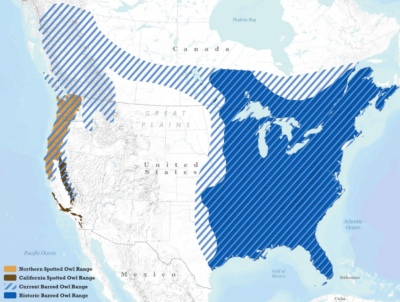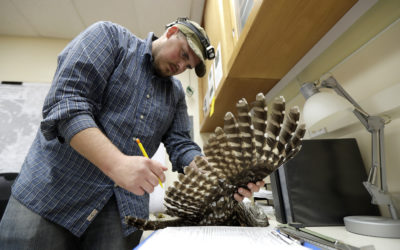On July 3, the U.S. Fish and Wildlife Service released a plan to start killing 15,000 barred owls a year in the Pacific Northwest, starting as soon as this fall. This extraordinary initiative — more than a dozen years in the making — is intended to save the imperiled northern spotted owl from extinction.
Barred owls have been moving west into spotted owl territory for decades, aggressively outcompeting them for prey and nesting sites. If its plan is adopted, the federal agency will soon launch what’s expected to be a three-decade campaign in which certified hunters will eventually shoot nearly half a million barred owls.
“We’re wildlife conservation professionals, and we don’t take this lightly,” said Bridget Moran, a field supervisor for the Fish and Wildlife Service in Bend, Oregon, who has been working on the strategy. “The spotted owl is at a crossroads. We have the science to indicate what we can do to conserve spotted owls, and [it’s] telling us that we must manage barred owls in addition to habitat to save them.”
The plan, as presented in a final environmental impact statement, has garnered opposition, largely from animal welfare and anti-hunting groups, but also support from mainstream environmental groups.
The Fish and Wildlife Service adopted its plan based largely on a study of “invader removal,” published in 2021, in which researchers set up five pairs of test plots. On one plot, they left barred owls and spotted owls to their own devices. On the other plot, they shot any barred owls that entered.
A long-term field experiment showed that where barred owls were killed, the population of spotted owls stabilized.
The researchers eliminated 2,485 barred owls over several years in the managed plots. Where barred owls and spotted owls were left alone, the population of the threatened species declined around 12 percent each year. Where barred owls were killed, the population of spotted owls stabilized.
“The use of long-term field experiments to test the effectiveness of removals in benefitting impacted native species is rare,” said David Wiens, a U.S. Geological Survey biologist and the lead author of the paper. “This study is the largest field experiment ever conducted on the demographic consequences of invasive competition between predatory birds.”
Steep population declines of northern spotted owls, which live only in old-growth forests of the Pacific Northwest, raised alarms more than 35 years ago. Continued logging of those forests, experts said at the time, would drive the bird to extinction. In June 1990, the bird was listed as a threatened species in the Pacific Northwest and logging in its habitat was restricted.
The federal action created a storm of controversy, but it prevented the extinction of the spotted owl. Efforts to prevent the disappearance of the owl, then and now, are not just about protecting a charismatic predator. Spotted owls are an indicator species for the health of the old-growth ecosystem: If a forest has adequate populations of flying squirrels, mice, and salamanders to sustain spotted owls, the forest is likely to be diverse and healthy. Spotted owls only live in old-growth forest, while barred owls can thrive in both young and old forests and eat a far wider range of prey.
Left: a barred owl. Right: a spotted owl.
Ray Bosch / U.S. Fish and Wildlife Service; David Roelofs / Bureau of Land Management
Logging of old growth forest on public lands has, for the most part, halted, and some logged areas are now being restored. But while the logging battles have died down, the new controversy over the proper response to what has been called an invasion of barred owls has heated up as the Fish and Wildlife Service’s final decision nears.
Biologists believe that the barred owl began moving out of eastern North America and across Canada with the westward movement of European settlers. In a two-part paper, the former FWS biologist Kent Livezey concluded that the lack of trees on the Great Plains created a barrier to owl movement until settlers appeared. They excluded fire from ecosystems, which eventually allowed forests to spread, and they planted trees on farms and in towns, all of which provided an expansion of roosting habitat. Wheat and other grain farms may have increased the numbers of mice and other prey.
Barred owls were first observed in Washington, Oregon, and California in the 1970s, and today there are more than 100,000 of them living in the northern spotted owl’s territory in those states, according to federal biologists.
When barred owls move into spotted owl habitat, the impact is rapid and thorough. The interlopers are larger and more aggressively territorial. They drive spotted owls away from their nests and outcompete the smaller birds for food. At least half the spotted owls in the forests of the West have been lost to barred owls, says the Fish and Wildlife Service, and some places have lost three-quarters of their historic population. When barred owls colonized Redwoods State and National Parks in Northern California, starting in 1987, the spotted owls all but disappeared.
Biologists considered capturing and sterilizing barred owls, but they would still return to their territory and displace spotted owls.
The plan to shoot barred owls will protect the northern spotted owl, a subspecies that occurs in Northern California, Oregon, Washington, and southern British Columbia, which now has fewer than five northern spotted owls, including a lone female.
The number of northern spotted owls in the United States isn’t precisely known: Estimates put the population at just a few thousand. Its continuing decline, however, is steep. In areas where roughly 200 spotted owls lived in the early 2000s, only two or three birds remain, said Robin Bown, a FWS biologist in Oregon. The bird is currently listed as threatened. FWS scientists say it is warranted for listing as endangered, but the agency says such action is precluded because it must focus on higher priority species.
The California spotted owl, another subspecies, was last year proposed for listing as endangered in the southern part of its range and threatened in the Sierra Nevada. Barred owls are just beginning their invasion of that bird’s habitat, and the FWS strategy is to dispatch them as soon as they are detected. The Mexican spotted owl is listed as threatened in both the U.S. and Mexico but is not currently threatened by the barred owl.
Though the plan to kill hundreds of thousands of owls is extreme, federal wildlife officials say other options simply aren’t available. Capturing the birds and moving them elsewhere was contemplated. “We contacted the eastern states where barred owls are native, to see if they wanted barred owls back,” said Bown. “They said ‘no.’ Their existing habitat is already full.” Moving them could also spread disease and parasites. They also considered capturing and caging barred owls, but maintaining so many birds would be prohibitively expensive, never mind the fact that there aren’t enough qualified facilities to house barred owls for the rest of their lives.

The ranges of barred owls, northern spotted owls, and California spotted owls.
U.S. Fish and Wildlife Service
Biologists also considered “reproductive interference” — capturing barred owls and sterilizing them. But released owls would simply return to their territory, displacing spotted owls, and stay there until they died, Bown said.
The federal government has long experience with eliminating wild animals to preserve endangered species. To protect endangered warblers and other songbirds, hundreds of thousands of cowbirds, a nest parasite, have been killed annually. Wildlife managers in Washington and Oregon lethally inject sea lions to protect salmon runs. Feral hogs are routinely slaughtered to protect threatened and endangered species.
The Fish and Wildlife Service plans to work with individual landowners and representatives from tribes and federal and state agencies, training and certifying volunteers to remove the invasive species as humanely as possible. The service emphasizes that there is no public hunting of barred owls permitted.
“Before anyone can do this, they have to meet our qualifications [for permitting],” said Bown. “They have to have training, knowledge, and experience.” Shooters will need to know their owls. Barred owls have a distinctive call that sounds like “Who cooks for you?” Though spotted and barred owls are similarly colored, barred owls are a bit larger and have vertical and horizontal striping, while spotted owl markings are horizontal.
Animal rights groups call the movement of invasive owls ‘adaptive range expansion’ and an instinctive response to climate change.
“We have removed 4,500 barred owls with the same protocol in experimental removals in the last 12 or 15 years without a single non-target injury or death,” said Bown. Shooters will head into the woods at night, with flashlights and megaphones. “We will project territorial barred-owl sounds,” said Bown, explaining what’s known as a callback survey. “If barred owls are there, they will respond and usually approach us.” Shooters must be within a hundred feet of their target, she said, and “have a good clean shot.” Carcasses will quickly be buried in the forest.
Around 15,000 barred owls will be killed each year for 30 years — totaling some 450,000 birds. Biologists estimate the maximum number of owls removed annually will be less than the estimated annual growth of the entire barred owl population.
The barred owl removal plan has drawn criticism as well as reluctant support. Hilary Franz, the Commissioner of Public Lands for Washington State, has concerns about the culling. She posted comments, which she sent to Secretary of the Interior Deb Haaland, about the planned culling on YouTube. “It raises enormous amounts of questions,” she said. “How can the Fish and Wildlife Service guarantee that only barred owls will be targeted? How can we prevent the surviving barred owls from simply recolonizing and repopulating the very areas we are trying to preserve? And with so many species now facing extinction, how can we justify spending nearly a billion dollars on one species when our funding and resources are limited?”
The Fish and Wildlife Service has said the cost of the project has not yet been tabulated.

Wildlife technician Jordan Hazan records data from a barred owl killed as part of an experiment aimed at preserving spotted owls, Corvallis, Oregon, October 2018.
Ted S. Warren / AP Photo
The primary opposition has come from animal rights and welfare organizations. In March, 75 organizations led by Animal Wellness Action president Wayne Pacelle sent a letter to Haaland opposing the shooting of the birds, calling the movement of invasive owls “adaptive range expansion” and an instinctive response to climate change. “We cannot victimize animals for adapting to human perturbations of the environment, perhaps especially the all-encompassing effects of climate change,” they wrote.
The Center for Biological Diversity, meanwhile, is supportive of the cull. “I hate to see any animal killed, but the spotted owl will certainly go extinct without an effort to reduce invasive barred owl populations,” said Noah Greenwald, the conservation group’s endangered species director. “I’m hopeful that in combination with protections for old-growth forests on federal lands, barred owl control will give the spotted owl a real chance at survival.” The American Bird Conservancy also supports the plan, as do some, but not all, Audubon chapters.
Denver Holt, a leading owl researcher who is president of the Owl Research Institute, in Charlo, Montana, questions whether the birds are truly invasive and believes their range expansion across the boreal forest in Canada may be natural. “I’m concerned,” he said. “They are using the invasive category to kill so many owls. I’d like to see an independent review.”
But the Fish and Wildlife Service says action must be taken now. “If we don’t do this, the spotted owl will go extinct,” said Bown. “That’s not a hard prediction to make.”
Correction, July 23, 2024: An earlier version of this article incorrectly stated that wildlife managers in Washington and Oregon lethally inject sea otters to protect salmon runs. They inject sea lions, not sea otters.










